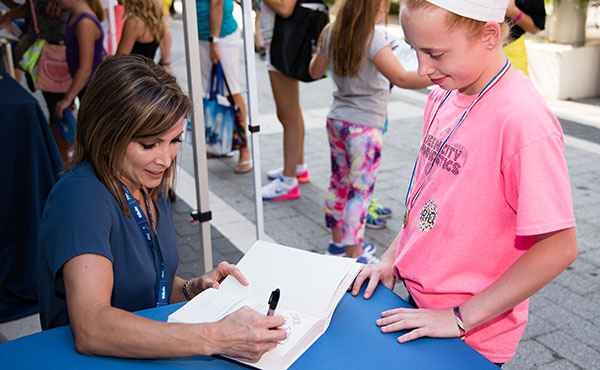
ST. LOUIS – Shannon Miller sat on the edge of the competition floor Friday night and couldn’t help herself: She had to get Simone Biles’ vault – that almost-perfect Amanar – on video.
“Do you know how to make this slow-mo?” She asked her seatmate.
A lot has changed – in gymnastics and in technology – since Miller wowed her way to team and balance beam gold in Atlanta in 1996. Her seven Olympic medals remain the standard among U.S. women, having won five at the Barcelona Games, as well.
This summer, Biles will go for five herself – most likely all of them gold – should all go as planned leading up to and at the Rio Olympics.
“She delivers so consistently,” said Miller, eyes following Biles after her vault rotation. “This will probably be her fourth national title, which is just incredible. She is just such a cool, calm and collected competitor. She may not feel that inside, but what she looks like out there, she takes control. I think that’s a settling feeling going into the Olympics, particularly for the first time. It sets a good tone for the rest of the team.”
It’s a team that will be carefully picked by women’s national team coordinator Martha Karolyi and the selection committee on July 10, at the conclusion of women’s trials in San Jose.
Miller, a member of the famed Magnificent Seven, sees the selection process as less of a daunting one more about building around the strength of Biles – and a pair of veterans.
“I think you have three or four incredibly dominant athletes – and very secure all around athletes – that the battle is for that last spot or two,” she said.
Two of those “three or four” that Miller mentions include Gabby Douglas and Aly Raisman, the lone remaining gymnasts from the 2012 Fierce Five team that captured team gold, which marked Team USA’s first team gold since the Magnificent Seven’s Atlanta conquering.
“It’s so incredibly hard to come back,” Miller said of Douglas and Raisman. “I love Gabby’s attitude of, ‘Hey, I’m not coming back, I’m just continuing on.’ I think that’s the mentality you have to have, even after taking a break. It’s hard to come back physically and mentally. She’s dealing with a new set of rules and all of these other athletes coming up. You’re dealing with your body changing, too, so for me it’s an incredible thing that they’re doing. It’s going to be great see them – hopefully – on Team USA again.”
Miller sees the rise of Biles – her three U.S. and World gold medals since 2013 – as a driving force for Douglas and Raisman, not to mention the whole of the U.S. women’s national program.
“With Biles out there, it makes you believe that it’s absolutely possible to stay in the sport and stay at the top of the sport so dominantly for such a long period of time,” Miller said, noting Biles’ three-year reign. “I think it’s incredible for these young athletes to see. And for the audience, they get to witness that, too.”
There was a new star on Friday night in St. Louis as 2015 junior national champion Laurie Hernandez, weeks after her 16th birthday, delivered as mature of a performance as you could ask. She sits second behind Biles, in a tie with Raisman in the all-around.
Miller, who was just 15 when she made her first Olympic team, has high hopes for Hernandez, too.
“I think she’s fantastic,” Miller said. “I love the fact that she has strong uneven bars. I think that’s going to help position her for a spot on this team. We probably know three spots, so it’s going to be up to these girls to show who the solid bar workers are. I think she fits that bill.”
With that Miller has to make her way to a Hershey’s event, a sponsor she is in St. Louis representing. But before she goes she finds a GIF that strikes her on Twitter, a clip of Biles gesturing during her floor routine, arms sweeping and outstretched, eyes beaming. The caption reads: “I’m your queen, gymternet.”
“Oh that is amazing,” Miller said, watching it on loop on her phone. “I have to retweet this.”




